You are here
DNA Laboratories
An accurate species identification is crucial for policy concern issues in order to enforce the respective regulations. Organisms of policy concern include for example endangered species protected under the CITES treaty, Invasive Alien Species, agricultural pest species, human and veterinary disease organisms and their vectors, organisms of the human food chain, forensically interesting species, species with economic impacts, etc. When a morphological identification is not possible (e.g. cryptic species, trace material, early life-stages), DNA barcoding can often offer a solution. This technique is a species identification method that uses a short genetic sequence (DNA barcode) to compare an unknown sample to a database of reference sequences with known species affiliations.
General information
The Barcoding Facility for Organisms and Tissues of Policy Concern (BopCo) aims to act as a focal point for the identification of biological materials of policy concern for all stakeholders who deal with such samples and who are in need of an accurate identification. Therefore, BopCo provides identifications upon request or connects individuals with taxonomic experts who possess the required know-how and means to identify the sample(s). Morphological species traits, DNA barcoding and, if needed or relevant, other DNA-based technologies are being used, alone or in combination, to provide reliable taxonomic identifications.
The graphs below demonstrate the diversity of the identification requests handled by BopCo according to the policy concern category of the request, the taxon to which the specimens belong, the type of stakeholder submitting the identification request and the outcome of the identification procedure. More information on species identification requests can be found on the BopCo website.
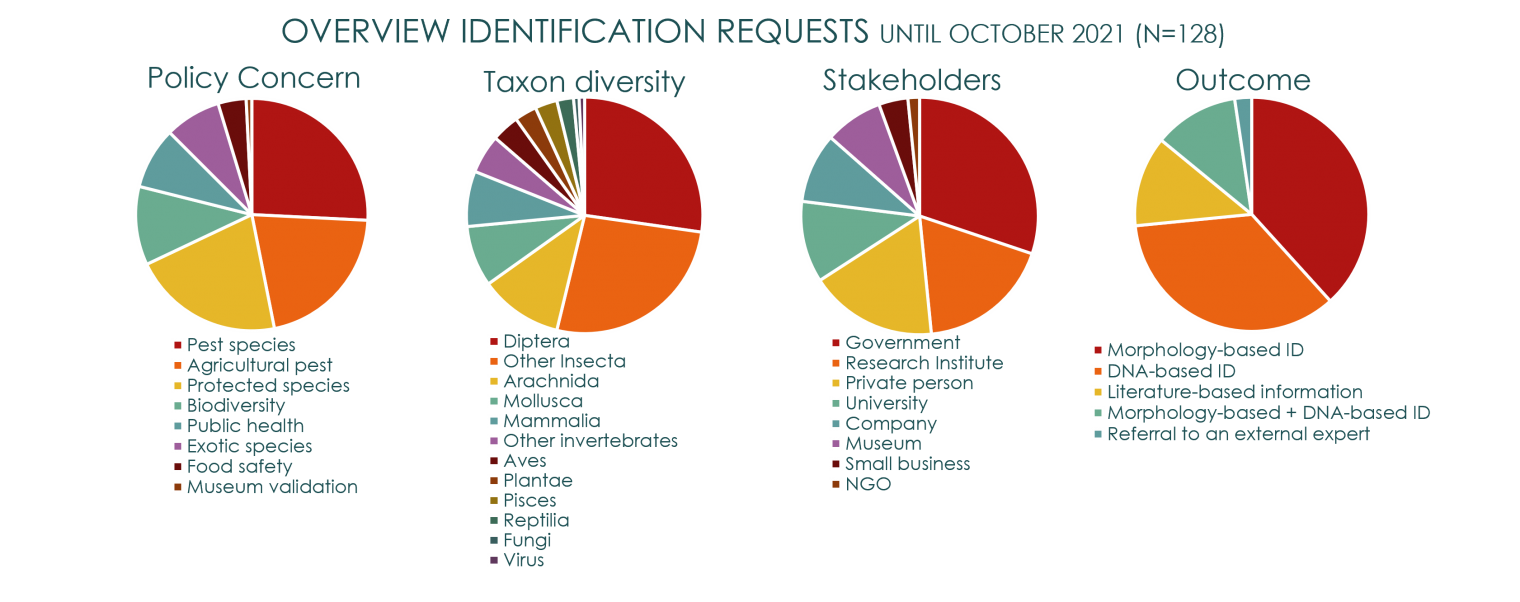
DNA sequences, either from unknown samples that need identification or from voucher material for building reference databases, are generated in a laboratory environment. The laboratories used by BopCo are located at the Royal Museum for Central Africa (RMCA) and the Royal Belgian Institute of Natural Sciences (RBINS). Here DNA is extracted and purified from tissues or processed materials and a specific region of the samples’ DNA is amplified by polymerase chain reaction (PCR). For animals the mitochondrial cytochrome c oxidase subunit 1 (COI) gene was proposed by the International Barcode of Life initiative as standard barcode region, for plants it concerns a combination of the maturase K gene (matK) and the ribulose-bisphosphate carboxylase gene (rbcL). However, BopCo will use alternative or additional genetic markers if necessary, depending on the samples and the required taxonomic level of identification. After amplification, the PCR products are purified and prepared for sequencing in-house or by an external sequencing facility. The generated sequences are then analysed and the species is identified by comparison with data available in online reference databases or in project-specific databases build by BopCo.
Infrastructure / Installation
Currently (January 2019) BopCo has access to five laboratories which are partly equipped with BopCo instruments. Both in the RBINS and RMCA buildings the lab facilities are separated over two rooms in order to prevent cross-contamination: a pre-PCR and post-PCR laboratory.
In the pre-PCR lab caution is required to avoid contamination with DNA from the environment, especially when working on sensitive materials containing a low quantity or poor quality of DNA. In this environment the sterilisation of all consumables is carried out using an autoclave and special care is taken to sterilise all work spaces and equipment before use. The procedures carried out in the pre-PCR lab include: (i) taking tissue samples from specimens, (ii) extracting DNA using either standardised kits or customised protocols, (iii) measuring the DNA concentration of the extracts, (iv) preparing the PCR mixtures, and (v) storing the DNA and tissue samples in assigned -20 °C freezers for later use.
When working with very sensitive or old samples which contain only little or potentially degraded DNA, a specially equipped ancient DNA lab is available at the RBINS. This specialised room is supplied with UV light and positive pressure airflow to avoid contamination with DNA from the outside environment.
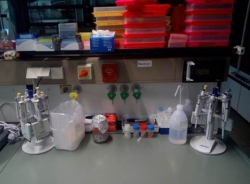
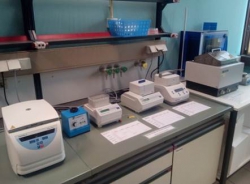
Left: Typical pre-PCR workbench - Right: pre-PCR equipment left to right: centrifuge, vortex mixer, three shaking heat blocks and a water bath. (Photographs ©BopCo)
In the post-PCR room the prepared DNA extracts are subjected to PCR amplification of the selected DNA fragment. This process requires thermocyclers; instruments that can ramp and hold a specific temperature precisely for short periods of time. To confirm that the PCR was successful the amplicons are visualised using agarose gel electrophoresis with UV transillumination. The successful PCR products are purified, clearing away leftover PCR reagents, and the purified PCR product is prepared for sequencing.
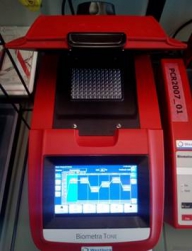

Left: Thermal cycler with on-screen cycling protocol - Right: gel electrophoresis tank and power supply - Insert: example of visualization of PCR results. (Photographs ©BopCo)
An ABI 3130XL Sequencer is available for use by BopCo at the RBINS laboratories. Sequencer output files can be checked, edited, analysed and compared using specialised programs.
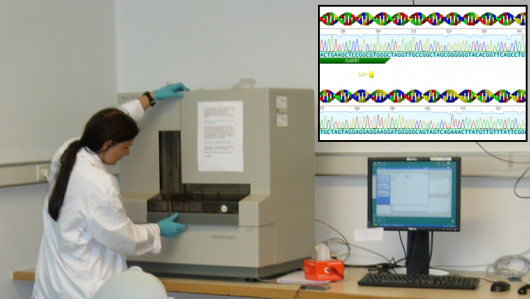
The RBINS ABI 3130XL Sequencer in use and inserted an example output file in Geneious software. (Photographs ©BopCo)
Additionally, BopCo has storage facilities for the preservation of both tissue samples and DNA-extracts. The tissue and specimen samples are stored in absolute ethanol (>96 %) at -80 °C. The DNA extracts are dried for long-term storage of DNA at room temperature using the GenTegra drying technology and are kept in ABgene 2D Barcode tubes in a dedicated GeneVault cupboard.

Illustration of Abgene 2D barcode tubes and storage boxes with VisionMate scanner (©ThermoFisher Scientific)
The fact that BopCo is jointly run by RBINS and RMCA means that it has easy access to the taxonomic expertise available at both research institutes, as well as to the large curated collections of specimens.
Applications / Data flow
Instead of developing a separate web portal, the barcode sequences produced by BopCo, as well as the associated metadata is made available via the Barcode Of Life Data Systems (BOLD Systems) and GenBank database platforms, from where the sequences can be downloaded for consultation and analysis.
